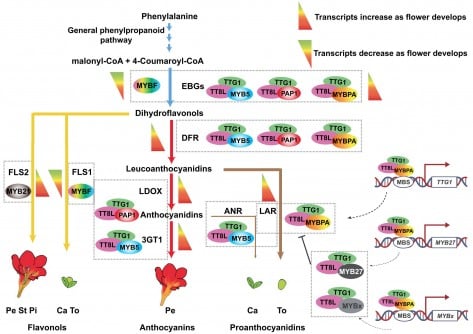URGENT UPDATE: Scientists have just revealed groundbreaking insights into the molecular mechanisms that dictate the vibrant pigmentation of Freesia flowers. A research team from Northeast Normal University, Jilin University, and the China Tobacco Gene Research Center has decoded the complex pathways involved in the production of proanthocyanidins (PAs), crucial for both color and plant defense.
This pivotal study, published on December 12, 2024, in Horticulture Research, highlights how four specific TT2-type MYB transcription factors—FhMYBPA1, FhMYBPA2, FhMYBPA3, and FhMYBPA4—are instrumental in regulating PA biosynthesis. The findings have immediate implications for ornamental horticulture and plant resilience, making this an essential read for anyone in the agricultural field.
The scientists utilized techniques such as gene expression profiling and protein interaction assays to uncover a sophisticated network that governs floral color and protection. Their findings indicate that these transcription factors act as activators of PA production, significantly correlating with the accumulation of these vital compounds in developing flowers.
“Our research highlights the remarkable complexity of floral metabolism,” stated Prof. Yueqing Li, the study’s corresponding author. The team discovered that FhMYBPA factors not only activate PA biosynthesis but also engage in a feedback system with both activators and repressors to maintain a harmonious balance of pigments and protective chemicals.
The study revealed that transient overexpression of FhMYBPAs in Freesia petals led to a significant surge in PA levels, showcasing the potential for manipulating flower coloration and enhancing plant resilience through targeted genetic engineering. The research also identified that these MYB proteins interact with an important partner, FhTT8L, to enhance the activation of PA biosynthetic genes.
With floral pigmentation linked to both aesthetic appeal and protective functions, this research opens new avenues for breeding ornamental plants with tailored pigmentation and improved stress tolerance. The implications extend beyond Freesia, offering insights that could revolutionize crop quality and resilience across various agricultural sectors.
As the scientific community delves deeper into the regulatory mechanisms of flavonoid biosynthesis, this study stands as a crucial step toward developing new plant varieties with enhanced antioxidant and nutritional properties. Understanding these pathways not only benefits ornamental horticulture but could also foster advancements in the broader field of plant metabolic engineering.
With these findings, researchers aim to influence how floriculture can adapt to environmental challenges, emphasizing the urgent need for innovation in agricultural practices. As this story develops, it promises to reshape our understanding of floral biology and its practical applications in crop improvement.
For further details, refer to the study published in Horticulture Research, accessible at DOI: 10.1093/hr/uhae352.







